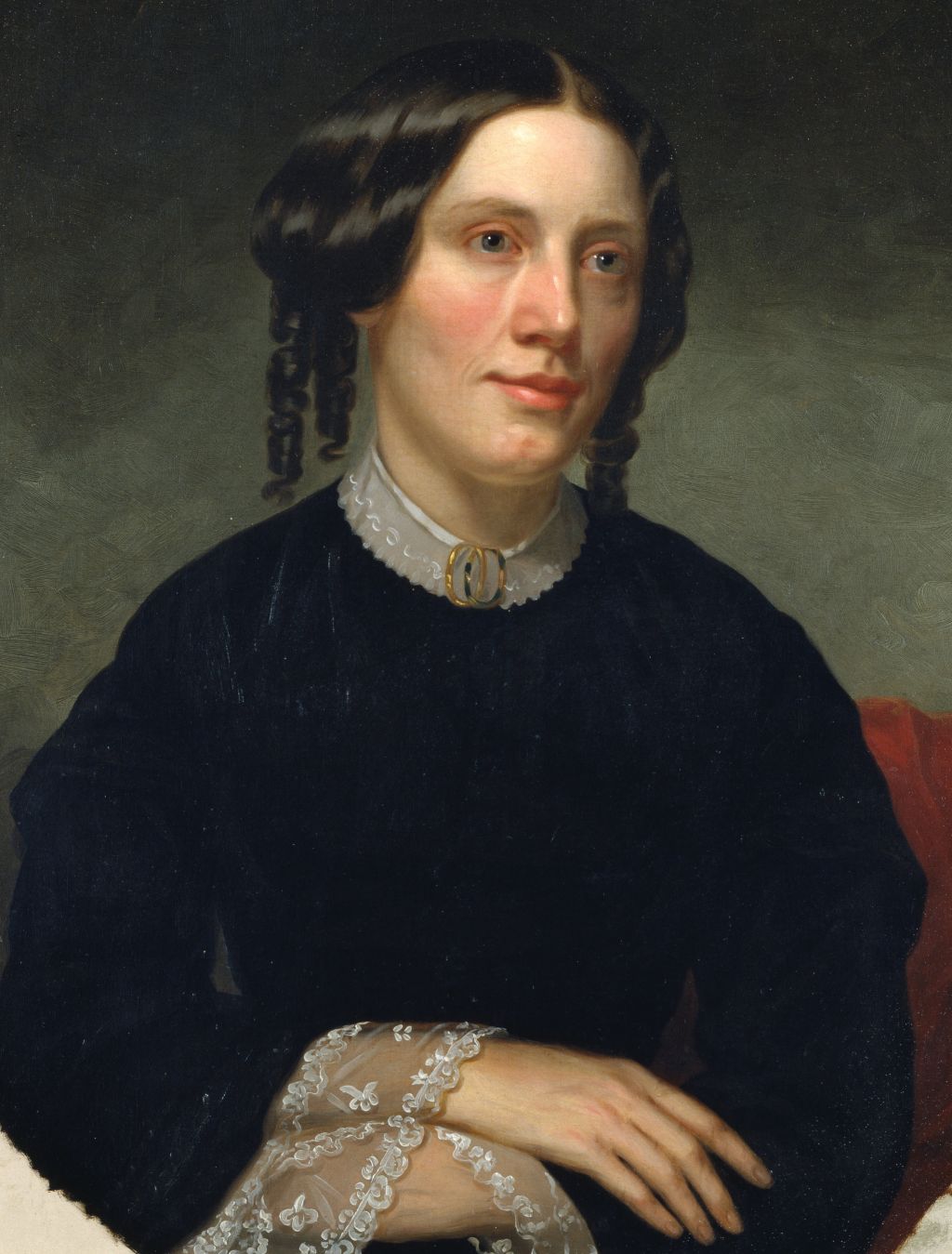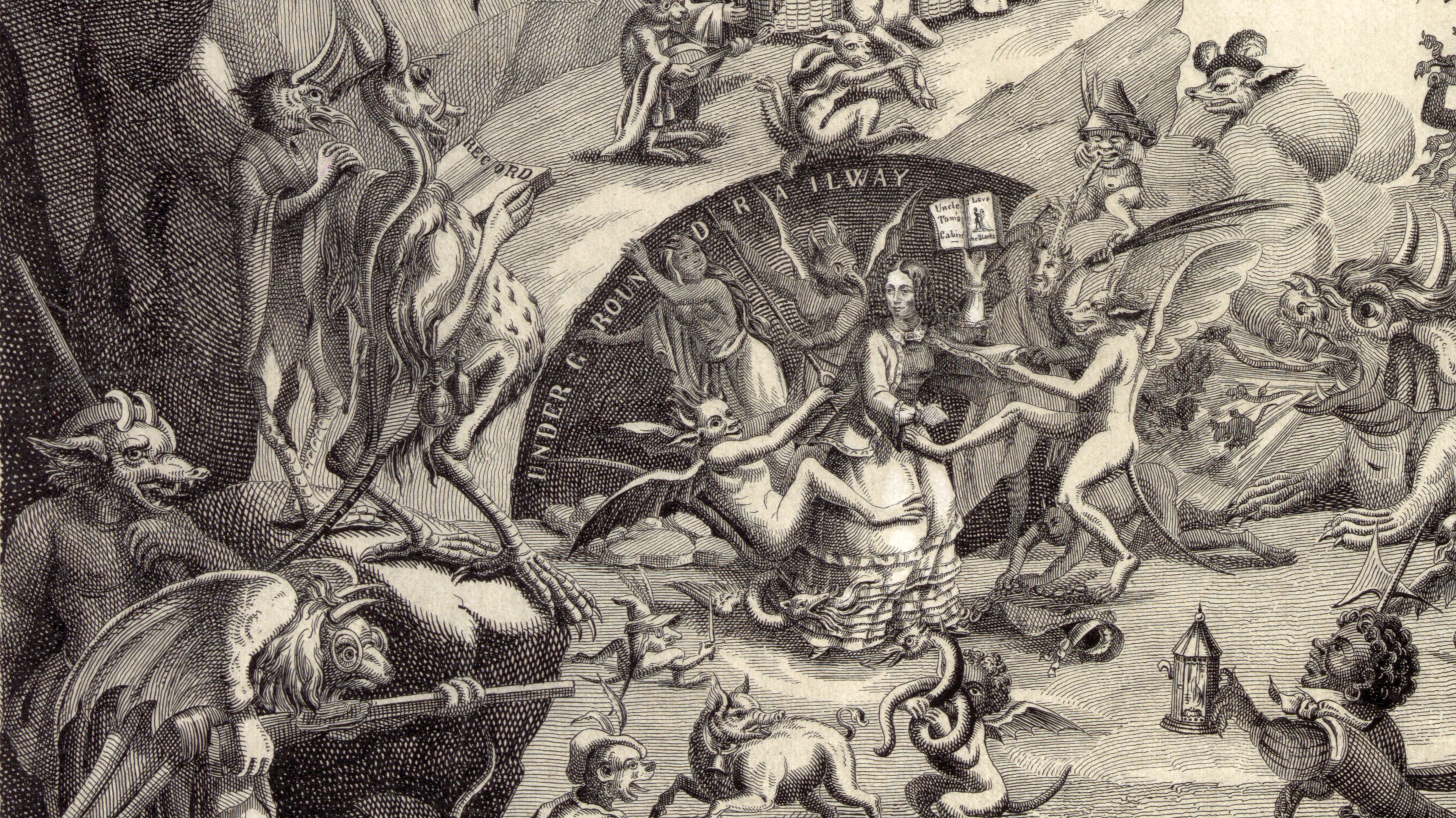Her novel helped to end slavery and proved that Lincoln was right when he said, “Whoever can change public opinion can change the government.”
-
Winter 2020
Volume64Issue1

Editor’s Note: David S. Reynolds is Distinguished Professor at the City University of New York, winner of the Bancroft Prize, and author or editor of 15 books about American history, literature and culture, including Walt Whitman's America and Mightier than the Sword: Uncle Tom's Cabin and the Battle for America, from which portions of this essay were adapted.
0n January 1, 1863, Harriet Beecher Stowe attended a concert held at the Boston Music Hall in celebration of Abraham Lincoln’s expected signing of the Emancipation Proclamation. Of the many galas held in the North that historic day, this one was especially impressive. Among the crowd of three thousand were Emerson, Longfellow, Whittier, Francis Parkman, and Oliver Wendell Holmes.
Two weeks earlier, Stowe had written her friend Charles Sumner, chair of the Senate Foreign Relations Committee, “Everybody I meet in New England says to me with anxious earnestness. Will the President stand firm to his Proclamation?“
The answer came during intermission at the Music Hall event. A speaker announced that the news had come over the wires that the president had signed the Proclamation, freeing millions of slaves in states disloyal to the Union. The hall erupted with applause, shouts, and handkerchief-waving. Three cheers went up for Lincoln. Three more followed for William Lloyd Garrison, mingled with hisses from those still hostile to the controversial abolitionist.
When Stowe was spotted in the balcony, a new chant swept through the hall: “Harriet Beecher Stowe! Harriet Beecher Stowe! Harriet Beecher Stowe!” Urged forward by those seated near her, her bonnet toppling off, she went to the railing, bowing and waving to the throng.
At that moment, the plain fifty-one-year-old Stowe, just five feet tall, was the most famous woman in America. Her wide-set eyes, which normally had a distant dreaminess, sparkled with emotion as tears flowed down her cheeks and her ample mouth broadened into a grin. Her aquiline nose gave her face a firm dignity that was softened by her gently sloped forehead and round cheeks framed by graying curls.
The crowd, convinced that she had helped make this moment possible, was responding to the torrent of energy unleashed by Stowe’s anti-slavery best-seller Uncle Tom’s Cabin; or, Life among the Lowly, published a decade earlier.
Did Lincoln feel this way about the novel, too? A month before the Boston event, Stowe had visited him in the White House to urge him to sign the Proclamation. His alleged greeting of her — “Is this the little woman who made this great war?” — is the most famous statement ever made about Uncle Tom’s Cabin. Whether he actually said it is moot. In his era, many claimed that Stowe had brought on the Civil War.
Surprisingly, this crucial topic has never been discussed in detail. Although the novel is vaguely associated in most people’s minds with the Civil War, several modern commentators have tried to argue that it had only a minimal influence on the political decisions leading to the war. One maintains that “its political effect” was “negligible.” Another writes that “sentiment limited the degree to which [the novel] could effect radical political change.” A third asks, “In what sense does a novel have the power to move a nation to battle?”
Such remarks ignore the tremendous authority of public opinion in America, which Tocqueville regarded as stronger than the government — an idea Lincoln echoed when he declared, “Our government rests in public opinion. Whoever can change public opinion can change the government.” In his debates against Stephen Douglas, Lincoln emphasized, “Public sentiment is everything . . . . He who moulds public sentiment is greater than he who makes statutes.”
No book in American history molded public opinion more powerfully than Uncle Tom’s Cabin. Published in 1852, it set sales records for American fiction. An international sensation, it was soon translated into many languages. The Boston preacher Theodore Parker declared that it was “more an event than a book, and has excited more attention than any book since the invention of printing.”
Henry James noted that Stowe’s novel was, “for an immense number of people, much less a book than a state of vision, of feeling and of consciousness in which they didn’t sit and read and appraise and pass the time, but walked and talked and laughed and cried.”
James was right. Sympathetic readers of Uncle Tom’s Cabin were thrilled when the fugitive slave Eliza Harris carried her child across the ice floes of the Ohio River and when her husband George fought off slave catchers in a rocky pass. They cried over the death of the angelic little Eva and were horrified by the fatal lashing of Uncle Tom, the gentle, strong enslaved black man. They guffawed at the impish slave girl Topsy and shed thankful tears when she embraced Christianity. They sneered at the selfish hypochondriac Marie St. Clare and loathed the cruel slaveowner Simon Legree. They were fascinated by the brooding, Byronic Augustine St. Clare and were appalled by the stories of sexual exploitation involving enslaved women like Prue and Cassy.
Recent decades have witnessed a remarkable upsurge of interest in Uncle Tom’s Cabin, but much remains to be said about the novel’s place in history and what came together in Stowe’s life and time to bring her to write it. The time is ripe for a thoroughgoing reassessment that gives the full measure of the novel’s rich cultural background and its enormous impact.
Uncle Tom’s Cabin was central to redefining American democracy on a more egalitarian basis. It helped rectify social injustice by affirming fairness and empowerment for marginalized or oppressed groups. The novel’s unprecedented popularity can be explained by the fact that it absorbed images from virtually every realm of culture — religion, reform, temperance tracts, antislavery writings, sensational pulp fiction, and popular performance — and brought these elements together in memorable characters and two compelling antislavery plotlines: the Northern one, involving the escape of the fugitive slaves Eliza and George Harris with their son Harry, and the Southern one, tracing the painful separation of Uncle Tom from his family when he is sold into the Deep South.
Stowe’s immersion in popular culture set the stage for her affecting novel. Other writers of the day, such as Melville, Hawthorne, and Whitman, were also responsive to popular images but transformed them into ambiguous symbols and characters. Stowe, in contrast, channeled them into a realistic human narrative with a crystal-clear social point: slavery was evil, and so were the political and economic institutions that supported it.
Uncle Tom’s Cabin directly shaped the political debates over slavery. Its dramatic portrait of the evils of slavery intensified the public sentiment behind the rise of Lincoln and the Republicans, while it caused a reactionary surge of proslavery feeling in the South, exacerbating the tensions that led to the Civil War. By the eve of the war, as one Southerner of the day noted, the novel “had given birth to a horror against slavery in the Northern mind which all the politicians could never have created “ and “did more than all else to array the North and South in compact masses against each other.”
The novel continued to provoke controversy through Reconstruction and beyond. Its influence was greatly amplified by tie-ins — popular plays and a host of merchandise known as Tomitudes.
Whether play or novel, Uncle Tom’s Cabin was important chiefly as an agent of emancipation. It gave impetus to revolutions in Russia, China, Brazil, Cuba, and elsewhere. In America, the novel remained particularly inspiring for African-Americans and progressive whites. Most recent commentators on the Uncle Tom plays and films have emphasized their dissemination of racial stereotypes. Actually, though, Stowe’s novel and its offshoots gave off unconventional, even revolutionary racial messages that seemed truly dangerous to white supremacists of the Jim Crow era, which lasted from the 1870s to the early 1960s.

Most notably, the popular Southern author Thomas Dixon attended an Uncle Tom play in 1901 and was so infuriated by what he regarded as its endorsement of black power that he wrote bitterly of Stowe, “A little Yankee woman wrote a book. The single act of that woman’s will caused the war, killed a million men, desolated and ruined the South, and changed the history of the world.”
Dixon responded to Uncle Tom’s Cabin by penning virulently racist, anti-Stowe novels that became massive best-sellers. One, The Clansman, was the basis of D. W. Griffith’s adeptly made yet thematically abhorrent film The Birth of a Nation (1915).
Even as the white supremacists were gaining a wide audience, Uncle Tom’s Cabin and its spin-offs helped keep alive Stowe’s progressive message. Stowe found ardent defenders among African-American leaders such as W. E. B. Du Bois and his fellow reformers in the NAACP. Over time, Stowe’s vision gained ascendancy in America. During the civil rights movement—despite the condemnation of being an “Uncle Tom”—those who acted in the spirit of Stowe’s firm-principled, nonviolent Uncle Tom, like Martin Luther King Jr., Rosa Parks, and thousands who participated in sit-ins and marches, proved the most successful in bringing about progressive change.
Stowe’s success was unlikely in a time when women had no political voice and in a nation which had few recognized authors.
That an author could have so great an impact as Harriet Beecher Stowe seems unlikely, if not impossible — especially for a time when women had no political voice and in a nation about which the Scottish writer Sydney Smith had sniffed in 1820, “In the four quarters of the globe, who reads an American book? Or goes to an American play?”
Stowe herself had a simple explanation of her success: God wrote Uncle Tom’s Cabin. After the novel became a best-seller and her brother Edward warned her not to become vain about its popularity, she told a friend, “Dear soul, he need not be troubled. He doesn’t know that I did not write that book.” Her friend exclaimed, “What! You did not write ‘Uncle Tom’?” Stowe replied, “No. I only put down what I saw . . . . It all came before me in visions, one after another, and I put them down in words.”
Stowe’s claims about the divine authorship of Uncle Tom’s Cabin may have satisfied her own pious yearnings, but they raise questions about the actual background and repercussions of the most influential book ever written by an American. The issues at the heart of Uncle Tom’s Cabin —race, religion, gender, law, morality, democracy — are just as vital today as they were in Stowe’s time. Exploring such questions gets to the very heart of the national experience.

